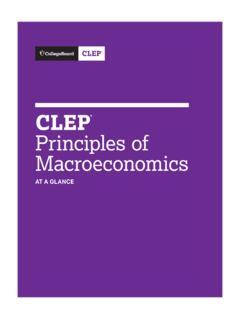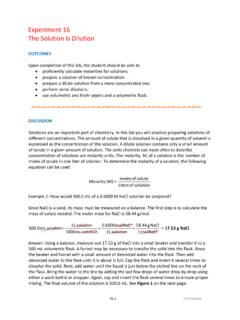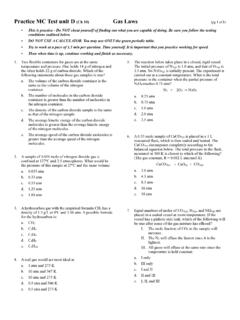Transcription of CLEP Chemistry
1 clep Chemistry AT A GLANCE Description of the Exam The Chemistry exam covers material that s usually taught in a one-year college course in general Chemistry . Understanding of the structure and states of matter, reaction types, equations and stoichiometry, equilibrium, kinetics, thermodynamics, and descriptive and experimental Chemistry is required, as is the ability to interpret and apply this material to new and unfamiliar problems. During this exam, an online scientific calculator function and a periodic table are available as part of the testing software. The exam contains approximately 75 questions to be answered in approximately 90 minutes. Some of these are pretest questions that won t be scored. Knowledge and Skills Required Questions on the Chemistry exam require candidates to demonstrate one or more of the following abilities.
2 Recall remember specific facts; demonstrate straightforward knowledge of information and familiarity with terminology Application understand concepts and reformulate information into other equivalent terms; apply knowledge to unfamiliar and/or practical situations; use mathematics to solve Chemistry problems Interpretation infer and deduce from data available and integrate information to form conclusions; recognize unstated assumptions The subject matter of the Chemistry exam is drawn from the following topics. The percentages next to the main topics indicate the approximate percentage of exam questions on that topic. 20% STRUCTURE OF MATTER Atomic theory and atomic structure Evidence for the atomic theory Atomic masses; determination by chemical and physical means Atomic number and mass number; isotopes and mass spectroscopy Electron energy levels: atomic spectra, atomic orbitals Periodic relationships, including, for example, atomic radii, ionization energies, electron affinities, oxidation states Nuclear Chemistry : nuclear equations, half-lives, and radioactivity.
3 Chemical applications Chemical bonding Binding forces wTypes: covalent, ionic, metallic, macromolecular (or network), dispersion, hydrogen bonding wRelationships to structure and to properties wPolarity of bonds, electronegativities VSEPR theory and Lewis electron-dot diagrams wHybridization of orbitals wGeometry of molecules, ions, and coordination complexes wStructural isomerism wResonance wSigma and pi bonds wDipole moments of molecules wRelation of properties to structure 19% STATES OF MATTER Gases Laws of ideal gases; equations of state for an ideal gas The mole concept; Avogadro s number Kinetic-molecular theory wInterpretation of ideal gas laws on the basis of this theory wDependence of kinetic energy of molecules on temperature: Boltzmann distribution wDeviations from ideal gas laws Liquids and solids Liquids and solids from the kinetic-molecular viewpoint Phase diagrams of one-component systems Changes of state, critical phenomena 2 Solutions Types of solutions and factors affecting solubility Methods of expressing concentration Colligative properties; for example, Raoult s law Effect of interionic attraction on colligative properties and solubility 12% REACTION TYPES Acid-base reactions; concepts of Arrhenius, Br nsted-Lowry, and Lewis.
4 Amphoterism Reactions involving coordination complexes Precipitation reactions Oxidation-reduction reactions Oxidation number The role of the electron in oxidation-reduction Electrochemistry; electrolytic cells, standard half-cell potentials, prediction of the direction of redox reactions, effect of concentration changes 10% EQUATIONS AND STOICHIOMETRY Ionic and molecular species present in chemical systems; net-ionic equations Stoichiometry: mass and volume relations with emphasis on the mole concept Balancing of equations, including those for redox reactions 7% EQUILIBRIUM Concept of dynamic equilibrium of physical and chemical changes; LeCh telier s principle; equilibrium constants Quantitative perspective Equilibrium constants for gaseous reactions in terms of both molar concentrations and partial pressure (Kc, Kp) Equilibrium constants for reactions in solutions wConstants for acids and bases: pK, pH wSolubility-product constants and their application to precipitation and the dissolution of slightly soluble compounds wConstants for complex ions wCommon ion effect.
5 Buffers 4% KINETICS Concept of rate of reaction: Order of reaction and rate constant Determination of order of reaction and rate constant from experimental data Effect of temperature change on rates Activation energy and the role of catalysts The relationship between the rate-determining step and a reaction mechanism 5% THERMODYNAMICS State functions First law: Heat of formation Heat of reaction, change in enthalpy, Hess s law Heat capacity; heats of vaporization and fusion Second law: Free energy of formation Free energy of reaction Dependence of change in free energy on enthalpy and entropy changes Relationship of change in free energy to equilibrium constants and electrode potentials 14% DESCRIPTIVE Chemistry The accumulation of certain specific facts of Chemistry is essential to enable students to: Comprehend the development of principles and concepts Demonstrate applications of principles Relate fact to theory and properties to structure Develop an understanding of systematic nomenclature that facilitates communication 3 The following areas are normally included on the exam: Chemical reactivity and products of chemical reactions Relationships in the periodic table.
6 Horizontal, vertical,and diagonal Chemistry of the main groups and transition elements, including typical examples of each Organic Chemistry , including such topics as functionalgroups and isomerism (may be treated as a separateunit or as exemplary material in other areas, such asbonding)9% EXPERIMENTAL Chemistry Some questions are based on laboratory experiments widely performed in general Chemistry and ask about the equipment used, observations made, calculations performed, and interpretation of the results. The questions are designed to provide a measure of understanding of the basic tools of Chemistry and their applications to simple chemical systems. Study Resources Most textbooks used in Chemistry courses cover the topics in the outline above, but the approaches to certain topics and the emphases given to them may differ.
7 To prepare for the Chemistry exam, it s advisable to study one or more college textbooks, which can be found in most college bookstores. A survey conducted by clep found that the following textbooks are among those used by college faculty who teach the equivalent course. Most of these have companion websites with practice test questions and other study resources. HINT: When selecting a textbook, check the table of contents against the preceding Knowledge and Skills Required section required for this exam. Chang and Overby, General Chemistry : The EssentialConcepts (McGraw-Hill) Cracolice and Peters, Introductory Chemistry : An ActiveLearning Approach (Brooks/Cole) Gilbert et al., Chemistry : The Science in Context( Norton) Goldberg, Fundamentals of Chemistry (McGraw-Hill) Hill, Kolb, and McCreary, Chemistry for Changing Times(Prentice-Hall) Joesten et al.
8 , The World of Chemistry : Essentials(Brooks/Cole) Kelter et al., Chemistry : A World of Choices(McGraw-Hill) Moog and Farrell, Chemistry : A Guided Inquiry (Wiley) Snyder, The Extraordinary Chemistry of OrdinaryThings (Wiley) Zumdahl and DeCoste, Introductory Chemistry : AFoundation (Brooks/Cole)In addition, the following resources, compiled by the clep test development committee and staff members, may help you study for your exam. However, none of these sources are designed specifically to provide preparation for a clep exam. The College Board has no control over their content and can t vouch for accuracy: Free online clep Chemistry course: Khan Academy Chemistry : Frostburg State University: General Chemistry Online: You can also find suggestions for exam preparation in Chapter IV of the clep Official Study Guide.
9 In addition, many college faculty members post their course materials on their schools websites. Sample Test Questions The following sample questions don t appear on an actual clep exam. They re intended to give potential test takers an indication of the format and difficulty level of the examination and to provide content for practice and review. For more sample questions and information about the test, see the clep Official Study Guide. Note: For all questions involving solutions and/or chemical equations, assume that the system is in pure water and at room temperature unless otherwise stated. 4 5 Questions 1 3 refer to reactions represented by the following chemical 2 KClO(s) 2 KCl(s) + 3 O (g)32B. Zn(s) + Cu2+(aq) Zn2+(aq) + Cu(s)C. Co3+(aq) + 6 NH3(aq) [Co(NH3)6]3+(aq)D. H3O+(aq) + NH3(aq) H2O(l) + NH4+(aq)E.
10 2 C8H18(l) + 25 O2(g) 16 CO2(g) + 18 H2O(g)1. A Br nsted-Lowry acid-base reaction 2. A decomposition reaction3. A combustion reaction4. The attractions between atoms within a molecule of NH3 are best characterized asA. hydrogen bondsB. ionic bondsC. polar covalent bondsD. London (dispersion) forcesE. ion-dipole forces5. Which of the following is the ground-state electron configuration of a halide ion?A. 1s2 2s22p5 B. 1s2 2s22p6C. 1s2 2s22p6 3s1D. 1s2 2s22p6 3s2 E. 1s2 2s22p6 3s23p1 6. What is the volume of a mol sample of a gas at 35 C and atm?A. LB. LC. LD. 19 L E. 38 L 7. R(g) + 2 T(g) 2 X(g) + Z(g) The reaction mixture represented above is at equilibrium at 298 K. The value of the equilibrium constant for the reaction is 16 at 298 K. If R(g), X(g), and Z(g) each have an equilibrium concentration of M, what is the equilibrium concentration of T(g)?










